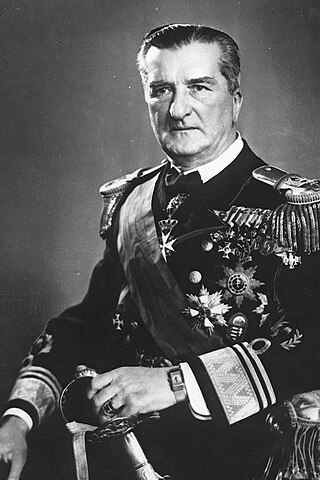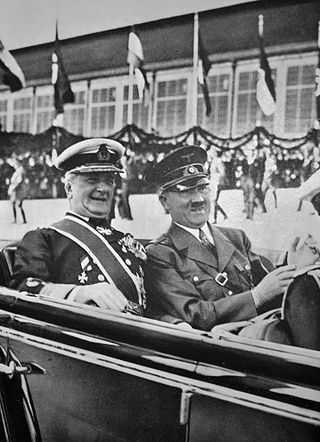German invasion of Hungary may refer to:
German invasion of Hungary may refer to:

Demographic features of the population of Hungary include population density, ethnicity, education level, health of the populace, economic status, religious affiliations and other aspects.
The Sinatra Doctrine was a Soviet foreign policy under Mikhail Gorbachev for allowing member states of the Warsaw Pact to determine their own domestic affairs. The name humourously alluded to the song "My Way" popularized by Frank Sinatra—the Soviet Union was allowing these states to go their own way. Its implementation was part of Gorbachev's doctrine of new political thinking.

The Warsaw Pact (WP), formally the Treaty of Friendship, Cooperation and Mutual Assistance (TFCMA), was a collective defense treaty signed in Warsaw, Poland, between the Soviet Union and seven other Eastern Bloc socialist republics of Central and Eastern Europe in May 1955, during the Cold War. The term "Warsaw Pact" commonly refers to both the treaty itself and its resultant military alliance, the Warsaw Treaty Organization (WTO). The Warsaw Pact was the military complement to the Council for Mutual Economic Assistance (Comecon), the economic organization for the Eastern Bloc states.

The Axis powers, originally called the Rome–Berlin Axis and also Rome–Berlin–Tokyo Axis, was a military coalition that initiated World War II and fought against the Allies. Its principal members were Nazi Germany, the Kingdom of Italy and the Empire of Japan. The Axis were united in their far-right positions and general opposition to the Allies, but otherwise lacked comparable coordination and ideological cohesion.

Miklós Horthy de Nagybánya was a Hungarian admiral and statesman who served as the regent of the Kingdom of Hungary during the interwar period and most of World War II, from 1 March 1920 to 15 October 1944.

The Munich Agreement was an agreement reached in Munich on 30 September 1938, by Nazi Germany, Great Britain, the French Republic, and Fascist Italy. The agreement provided for the German annexation of part of Czechoslovakia called the Sudetenland, where more than three million people, mainly ethnic Germans, lived. The pact is also known in some areas as the Munich Betrayal, because of a previous 1924 alliance agreement and a 1925 military pact between France and the Czechoslovak Republic.

The military occupation of Czechoslovakia by Nazi Germany began with the German annexation of the Sudetenland in 1938, continued with the creation of the Protectorate of Bohemia and Moravia, and by the end of 1944 extended to all parts of Czechoslovakia.
Central European may mean:

In March 1944, Hungary was invaded and occupied by the Wehrmacht. This invasion was formally known as Operation Margarethe.

The Balkans campaign of World War II began with the Italian invasion of Greece on 28 October 1940. In the early months of 1941, Italy's offensive had stalled and a Greek counter-offensive pushed into Albania. Germany sought to aid Italy by deploying troops to Romania and Bulgaria and attacking Greece from the east. Meanwhile, the British landed troops and aircraft to shore up Greek defences. A coup d'état in Yugoslavia on 27 March caused Adolf Hitler to order the conquest of that country.

Count Pál János Ede Teleki de Szék was a Hungarian politician who served as Prime Minister of the Kingdom of Hungary from 1920 to 1921 and from 1939 to 1941. He was also an expert in geography, a university professor, a member of the Hungarian Academy of Sciences, and chief scout of the Hungarian Scout Association. He descended from an aristocratic family from Transylvania.

From the 1220s into the 1240s, the Mongols conquered the Turkic states of Volga Bulgaria, Cumania and Iranian state of Alania, and various principalities in Eastern Europe. Following this, they began their invasion into Central Europe by launching a two-pronged invasion of then-fragmented Poland, culminating in the Battle of Legnica, and the Kingdom of Hungary, culminating in the Battle of Mohi. Invasions were also launched into the Caucasus against the Kingdom of Georgia, the Chechens, the Ingush, and Circassia though they failed to fully subjugate the latter. More invasions were launched in Southeast Europe against Bulgaria, Croatia, and the Latin Empire. The operations were planned by General Subutai (1175–1248) and commanded by Batu Khan and Kadan, two grandsons of Genghis Khan. Their conquests integrated much of Eastern European territory into the empire of the Golden Horde. Warring European princes realized they had to cooperate in the face of a Mongol invasion, so local wars and conflicts were suspended in parts of central Europe, only to be resumed after the Mongols had withdrawn. After the initial invasions, subsequent raids and punitive expeditions continued into the late 13th century.

The July Crisis was a series of interrelated diplomatic and military escalations among the major powers of Europe in the summer of 1914, which led to the outbreak of World War I. The crisis began on 28 June 1914, when Gavrilo Princip, a Bosnian Serb nationalist, assassinated Archduke Franz Ferdinand, heir presumptive to the Austro-Hungarian throne, and his wife Sophie, Duchess of Hohenberg. A complex web of alliances, coupled with the miscalculations of numerous political and military leaders, resulted in an outbreak of hostilities amongst most of the major European states by early August 1914.

Feldioara is a commune in Brașov County, Transylvania, Romania, about 15 km (9.3 mi) north of the city of Brașov. It is composed of three villages: Colonia Reconstrucția (Bohntelep), Feldioara, and Rotbav.

The invasion of Yugoslavia, also known as the April War or Operation 25, was a German-led attack on the Kingdom of Yugoslavia by the Axis powers which began on 6 April 1941 during World War II. The order for the invasion was put forward in "Führer Directive No. 25", which Adolf Hitler issued on 27 March 1941, following a Yugoslav coup d'état that overthrew the pro-Axis government.

During World War II, the Kingdom of Hungary was a member of the Axis powers. In the 1930s, the Kingdom of Hungary relied on increased trade with Fascist Italy and Nazi Germany to pull itself out of the Great Depression. Hungarian politics and foreign policy had become more stridently nationalistic by 1938, and Hungary adopted an irredentist policy similar to Germany's, attempting to incorporate ethnic Hungarian areas in neighboring countries into Hungary. Hungary benefited territorially from its relationship with the Axis. Settlements were negotiated regarding territorial disputes with the Czechoslovak Republic, the Slovak Republic, and the Kingdom of Romania. On November 20, 1940, Hungary became the fourth member to join the Axis powers when it signed the Tripartite Pact. The following year, Hungarian forces participated in the invasion of Yugoslavia and the invasion of the Soviet Union. Their participation was noted by German observers for its particular cruelty, with occupied peoples subjected to arbitrary violence. Hungarian volunteers were sometimes referred to as engaging in "murder tourism."

The Slovak invasion of Poland occurred during Nazi Germany's invasion of Poland in September 1939. The recently created Slovak Republic joined the attack, and Field Army Bernolák contributed over 50,000 soldiers in three divisions. Since most of the Polish forces were engaged with the German armies, which were more to the north of the southern border, the Slovak invasion met only weak resistance and suffered minimal losses.

Mongol incursions in the Holy Roman Empire took place in the spring of 1241 and again in the winter of 1241–42. They were part of the first Mongol invasion of Europe.
Invasion of Hungary may refer to: